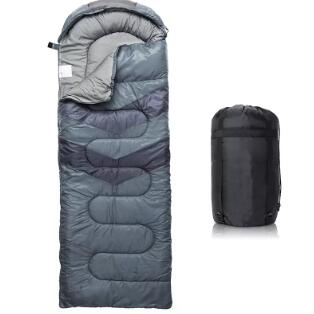Exploring Materials: Construction of Lightweight Compact Camping Sleeping Bags
2024-02-19
Introduction:
When it comes to camping gear, the materials used in construction play a vital role in determining the performance, durability, and overall comfort of the product. In the case of lightweight compact camping sleeping bags, understanding the materials used for both insulation and outer shell is crucial for making an informed decision. In this blog post, we'll delve into the materials commonly found in the construction of these sleeping bags, exploring their properties and how they contribute to the functionality of the product.
Insulation Materials:
Insulation is the primary component of a sleeping bag responsible for retaining body heat and keeping campers warm during outdoor adventures. Several types of insulation materials are used in lightweight compact camping sleeping bags, each with its unique characteristics:
1. Down Insulation: Down is prized for its exceptional warmth-to-weight ratio and compressibility. It is typically sourced from the plumage of ducks or geese and consists of fine clusters that trap air to provide insulation. Down sleeping bags are highly compressible and offer excellent warmth retention, making them ideal for cold weather camping.
2. Synthetic Insulation: Synthetic insulation is made from polyester fibers designed to mimic the properties of natural down. While synthetic sleeping bags may not offer the same level of warmth-to-weight ratio as down, they excel in damp conditions as they retain their insulating properties when wet. Synthetic sleeping bags are often more affordable and easier to clean than down alternatives.
Outer Shell Materials:
The outer shell of a sleeping bag serves as a protective barrier against moisture, abrasion, and wear. Common materials used for the outer shell of lightweight compact camping sleeping bags include:
1. Ripstop Nylon: Ripstop nylon is a durable and lightweight fabric known for its excellent tear resistance. It features a grid pattern of reinforcement threads that prevent tears from spreading, making it ideal for outdoor gear such as sleeping bags. Ripstop nylon shells offer a balance of strength, water resistance, and packability.
2. Polyester Taffeta: Polyester taffeta is a smooth and lightweight fabric commonly used in sleeping bag shells. It provides a soft, comfortable feel against the skin while offering water resistance and durability. Polyester taffeta shells are often treated with a DWR (Durable Water Repellent) coating to enhance water resistance and prevent moisture from penetrating the fabric.
3. Pertex® Quantum: Pertex® Quantum is a high-performance fabric known for its exceptional strength-to-weight ratio and wind resistance. It is incredibly lightweight and packable, making it an excellent choice for lightweight camping gear. Pertex® Quantum shells offer protection against wind and light precipitation while maintaining breathability for optimal comfort.
Conclusion:
The materials used in the construction of lightweight compact camping sleeping bags play a critical role in their performance, durability, and comfort. Whether it's the insulation providing warmth or the outer shell offering protection from the elements, each material serves a specific purpose in enhancing the functionality of the sleeping bag. By understanding the properties of these materials, campers can make informed decisions when selecting the perfect sleeping bag for their outdoor adventures.



